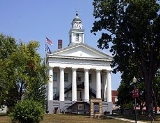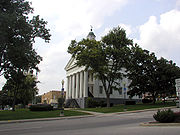
Paoli, Indiana
Encyclopedia
Paoli is a town in Paoli Township
, Orange County
, Indiana
, United States
. The population was 3,844 at the 2000 census. The town is the county seat
of Orange County
.
by transporting enslaved people from the South to Canada.
According to the United States Census Bureau
, the town has a total area of 3.8 square miles (9.8 km²), all of it land.
of 2000, there were 3,844 people, 1,581 households, and 1,013 families residing in the town. The population density
was 1,016.0 people per square mile (392.6/km²). There were 1,725 housing units at an average density of 455.9 per square mile (176.2/km²). The racial makeup of the town was 98.34% White, 0.21% African American, 0.23% Native American, 0.18% Asian, 0.18% from other races
, and 0.86% from two or more races. Hispanic or Latino of any race were 0.70% of the population.
 There were 1,581 households out of which 31.2% had children under the age of 18 living with them, 49.7% were married couples
There were 1,581 households out of which 31.2% had children under the age of 18 living with them, 49.7% were married couples
living together, 11.2% had a female householder with no husband present, and 35.9% were non-families. 32.5% of all households were made up of individuals and 16.1% had someone living alone who was 65 years of age or older. The average household size was 2.31 and the average family size was 2.90.
In the town the population was spread out with 23.7% under the age of 18, 8.7% from 18 to 24, 27.7% from 25 to 44, 21.5% from 45 to 64, and 18.3% who were 65 years of age or older. The median age was 38 years. For every 100 females there were 91.3 males. For every 100 females age 18 and over, there were 87.2 males.
The median income for a household in the town was $26,962, and the median income for a family was $34,412. Males had a median income of $28,566 versus $20,110 for females. The per capita income
for the town was $14,313. About 12.8% of families and 15.1% of the population were below the poverty line, including 15.2% of those under age 18 and 13.3% of those age 65 or over.
Paoli Township, Orange County, Indiana
Paoli Township is one of ten townships in Orange County, Indiana, USA. As of the 2000 census, its population was 5,890.-Geography:According to the United States Census Bureau, Paoli Township covers an area of ; of this, is land and is water.-Unincorporated towns:* Braxtons Siding at *...
, Orange County
Orange County, Indiana
As of the census of 2000, there were 19,306 people, 7,621 households, and 5,342 families residing in the county. The population density was 48 people per square mile . There were 8,348 housing units at an average density of 21 per square mile...
, Indiana
Indiana
Indiana is a US state, admitted to the United States as the 19th on December 11, 1816. It is located in the Midwestern United States and Great Lakes Region. With 6,483,802 residents, the state is ranked 15th in population and 16th in population density. Indiana is ranked 38th in land area and is...
, United States
United States
The United States of America is a federal constitutional republic comprising fifty states and a federal district...
. The population was 3,844 at the 2000 census. The town is the county seat
County seat
A county seat is an administrative center, or seat of government, for a county or civil parish. The term is primarily used in the United States....
of Orange County
Orange County, Indiana
As of the census of 2000, there were 19,306 people, 7,621 households, and 5,342 families residing in the county. The population density was 48 people per square mile . There were 8,348 housing units at an average density of 21 per square mile...
.
History
Paoli is a former Quaker town that played a role in the Underground RailroadUnderground Railroad
The Underground Railroad was an informal network of secret routes and safe houses used by 19th-century black slaves in the United States to escape to free states and Canada with the aid of abolitionists and allies who were sympathetic to their cause. The term is also applied to the abolitionists,...
by transporting enslaved people from the South to Canada.
Geography
Paoli is located at 38°33′28"N 86°28′9"W (38.557681, -86.469209).According to the United States Census Bureau
United States Census Bureau
The United States Census Bureau is the government agency that is responsible for the United States Census. It also gathers other national demographic and economic data...
, the town has a total area of 3.8 square miles (9.8 km²), all of it land.
Demographics
As of the censusCensus
A census is the procedure of systematically acquiring and recording information about the members of a given population. It is a regularly occurring and official count of a particular population. The term is used mostly in connection with national population and housing censuses; other common...
of 2000, there were 3,844 people, 1,581 households, and 1,013 families residing in the town. The population density
Population density
Population density is a measurement of population per unit area or unit volume. It is frequently applied to living organisms, and particularly to humans...
was 1,016.0 people per square mile (392.6/km²). There were 1,725 housing units at an average density of 455.9 per square mile (176.2/km²). The racial makeup of the town was 98.34% White, 0.21% African American, 0.23% Native American, 0.18% Asian, 0.18% from other races
Race (United States Census)
Race and ethnicity in the United States Census, as defined by the Federal Office of Management and Budget and the United States Census Bureau, are self-identification data items in which residents choose the race or races with which they most closely identify, and indicate whether or not they are...
, and 0.86% from two or more races. Hispanic or Latino of any race were 0.70% of the population.

Marriage
Marriage is a social union or legal contract between people that creates kinship. It is an institution in which interpersonal relationships, usually intimate and sexual, are acknowledged in a variety of ways, depending on the culture or subculture in which it is found...
living together, 11.2% had a female householder with no husband present, and 35.9% were non-families. 32.5% of all households were made up of individuals and 16.1% had someone living alone who was 65 years of age or older. The average household size was 2.31 and the average family size was 2.90.
In the town the population was spread out with 23.7% under the age of 18, 8.7% from 18 to 24, 27.7% from 25 to 44, 21.5% from 45 to 64, and 18.3% who were 65 years of age or older. The median age was 38 years. For every 100 females there were 91.3 males. For every 100 females age 18 and over, there were 87.2 males.
The median income for a household in the town was $26,962, and the median income for a family was $34,412. Males had a median income of $28,566 versus $20,110 for females. The per capita income
Per capita income
Per capita income or income per person is a measure of mean income within an economic aggregate, such as a country or city. It is calculated by taking a measure of all sources of income in the aggregate and dividing it by the total population...
for the town was $14,313. About 12.8% of families and 15.1% of the population were below the poverty line, including 15.2% of those under age 18 and 13.3% of those age 65 or over.

